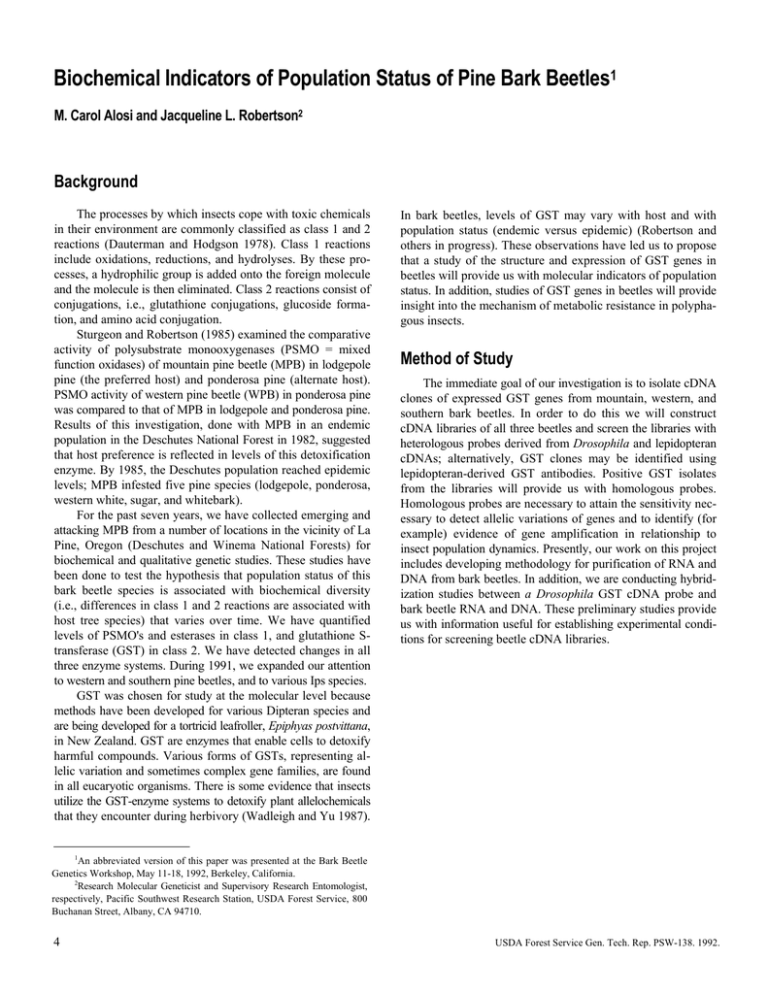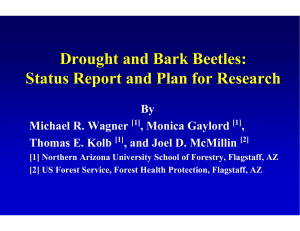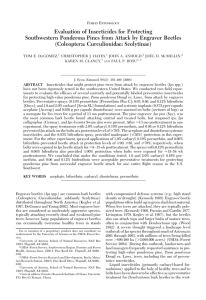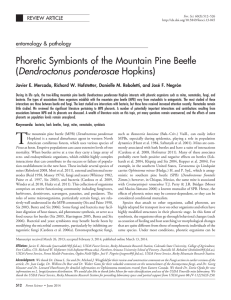Biochemical Indicators of Population Status of Pine Bark Beetles Background 1
advertisement

Biochemical Indicators of Population Status of Pine Bark Beetles1 M. Carol Alosi and Jacqueline L. Robertson2 Background The processes by which insects cope with toxic chemicals in their environment are commonly classified as class 1 and 2 reactions (Dauterman and Hodgson 1978). Class 1 reactions include oxidations, reductions, and hydrolyses. By these processes, a hydrophilic group is added onto the foreign molecule and the molecule is then eliminated. Class 2 reactions consist of conjugations, i.e., glutathione conjugations, glucoside formation, and amino acid conjugation. Sturgeon and Robertson (1985) examined the comparative activity of polysubstrate monooxygenases (PSMO = mixed function oxidases) of mountain pine beetle (MPB) in lodgepole pine (the preferred host) and ponderosa pine (alternate host). PSMO activity of western pine beetle (WPB) in ponderosa pine was compared to that of MPB in lodgepole and ponderosa pine. Results of this investigation, done with MPB in an endemic population in the Deschutes National Forest in 1982, suggested that host preference is reflected in levels of this detoxification enzyme. By 1985, the Deschutes population reached epidemic levels; MPB infested five pine species (lodgepole, ponderosa, western white, sugar, and whitebark). For the past seven years, we have collected emerging and attacking MPB from a number of locations in the vicinity of La Pine, Oregon (Deschutes and Winema National Forests) for biochemical and qualitative genetic studies. These studies have been done to test the hypothesis that population status of this bark beetle species is associated with biochemical diversity (i.e., differences in class 1 and 2 reactions are associated with host tree species) that varies over time. We have quantified levels of PSMO's and esterases in class 1, and glutathione Stransferase (GST) in class 2. We have detected changes in all three enzyme systems. During 1991, we expanded our attention to western and southern pine beetles, and to various Ips species. GST was chosen for study at the molecular level because methods have been developed for various Dipteran species and are being developed for a tortricid leafroller, Epiphyas postvittana, in New Zealand. GST are enzymes that enable cells to detoxify harmful compounds. Various forms of GSTs, representing allelic variation and sometimes complex gene families, are found in all eucaryotic organisms. There is some evidence that insects utilize the GST-enzyme systems to detoxify plant allelochemicals that they encounter during herbivory (Wadleigh and Yu 1987). In bark beetles, levels of GST may vary with host and with population status (endemic versus epidemic) (Robertson and others in progress). These observations have led us to propose that a study of the structure and expression of GST genes in beetles will provide us with molecular indicators of population status. In addition, studies of GST genes in beetles will provide insight into the mechanism of metabolic resistance in polyphagous insects. Method of Study The immediate goal of our investigation is to isolate cDNA clones of expressed GST genes from mountain, western, and southern bark beetles. In order to do this we will construct cDNA libraries of all three beetles and screen the libraries with heterologous probes derived from Drosophila and lepidopteran cDNAs; alternatively, GST clones may be identified using lepidopteran-derived GST antibodies. Positive GST isolates from the libraries will provide us with homologous probes. Homologous probes are necessary to attain the sensitivity necessary to detect allelic variations of genes and to identify (for example) evidence of gene amplification in relationship to insect population dynamics. Presently, our work on this project includes developing methodology for purification of RNA and DNA from bark beetles. In addition, we are conducting hybridization studies between a Drosophila GST cDNA probe and bark beetle RNA and DNA. These preliminary studies provide us with information useful for establishing experimental conditions for screening beetle cDNA libraries. 1 An abbreviated version of this paper was presented at the Bark Beetle Genetics Workshop, May 11-18, 1992, Berkeley, California. 2 Research Molecular Geneticist and Supervisory Research Entomologist, respectively, Pacific Southwest Research Station, USDA Forest Service, 800 Buchanan Street, Albany, CA 94710. 4 USDA Forest Service Gen. Tech. Rep. PSW-138. 1992.







